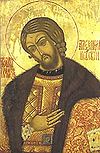- Mikhail Tikhonravov
-
Mikhail Klavdievich Tikhonravov (July 29, 1900, Vladimir - March 3, 1974) was a Soviet pioneer of spacecraft design and rocketry. Mikhail Klavdievich attended the Zhukovsky Air Force Academy from 1922 to 1925, where he built gliders and was exposed to Konstantin Tsiolkovsky's ideas of spaceflight. In 1932, he joined GIRD, as one of the four brigade leaders. His brigade built the GIRD-09 rocket, fueled by liquid oxygen and jellied gasoline, and launched on August 17, 1933.
Tikhonravov remained in GIRD as it evolved into RNII, the jet propulsion institute, and then NII-1. In 1946, he became deputy chief of NII-4 in the Academy of Artillery Science. There, he led a team of researchers that did important studies on packet rockets, satellite orbital motion, optimal pitch control programs for launching into orbit, reentry trajectories and heat shielding. This team designed Sputnik-3, Luna-1, Luna-3, Luna-4 and the early Venus and Mars probes. In 1956, Sergey Korolev had Tikhonravov and his team transferred into his bureau, OKB-1.
Tikhonravov Crater on Mars is named after Mikhail Tikhonravov [1]
References
External links
People from Russia Leaders and religious - Pre-1168
- 1168–1917
- 1922–1991
- 1991–present
- RSFSR leaders
- General secretaries
- Soviet premiers (1st deputies)
- Soviet heads of state (and their spouses)
- Prime ministers (1st deputies)
- Foreign ministers
- Prosecutors general
- Metropolitans and patriarchs
- Saints

Military and explorers - Field marshals
- Soviet marshals
- Admirals
- Aviators
- Cosmonauts
Scientists and inventors - Aerospace engineers
- Astronomers and astrophysicists
- Biologists
- Chemists
- Earth scientists
- Electrical engineers
- IT developers
- Linguists and philologists
- Mathematicians
- Naval engineers
- Physicians and psychologists
- Physicists
- Weaponry makers
Artists and writers Sportspeople - Chess players
Categories:- 1900 births
- 1974 deaths
- People from Vladimir
- Early spaceflight scientists
- Soviet space program personnel
- Russian inventors
Wikimedia Foundation. 2010.
